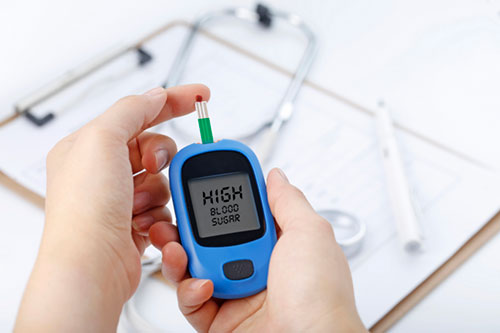The growing epidemic of diabetes poses serious concerns about the escalating socioeconomic crisis globally. Despite path-breaking scientific discoveries, the availability of better healthcare infrastructure and a rise in literacy rates, the burden of diabetes is burgeoning across the world. Around 10% of the global population has diabetes and nearly fifty per cent are not even diagnosed. It is heartening to know that type 2 diabetes and its complications can be prevented or delayed by adopting and maintaining healthy habits. The International Diabetes Federation has adopted the theme, ‘Know Your Risk, Know Your Response’, for World Diabetes Day on November 14, 2023, with the aim of educating people about their risk and the action to be taken for prevention, early diagnosis and timely treatment.

“Over the past couple of decade’s researches, technological and scientific breakthrough have facilitated the emergence of precision diabetes care and management of type 2 diabetes.”
Is Diabetes Reversal a Possibility?
Professor Roy Taylor at Newcastle University has confirmed that a low-calorie diet can reverse type 2 diabetes. A programme by NHS and Diabetes UK has revealed that a 3-month specially formulated low-calorie diet comprising of 800 to 900 kcal a day along with lifestyle changes helped people with type 2 diabetes and obesity reduce weight by more than 10 kg. It also helped reduce blood sugar and reduce the medication needed for diabetes. With the changes, 50% of the participants with type 2 diabetes went into remission.
“With a low carb, healthy protein diet of 800-900 k calories per day it is possible to achieve a HbA1C level of 6 or even 5.7 without medication which is called diabetes remission and if the patient continues with HbA1C of 5.7 for a long period, we call it diabetes reversal. It is definitely possible to achieve diabetes remission if we adopt a multi-disciplinary approach comprising a team of diabetologists, a nutritionist, a psychologist and a physiotherapist and offer individualised treatment.”
Know Your Risk
Glucose tolerance test is a gold standard test to diagnose diabetes. Fasting blood sugar levels are considered normal if readings are below 100 and diabetic if more than 125. Persons with blood sugar levels between 100 and 125 are considered to have impaired fasting glucose (IFG) or are pre-diabetic.
Blood sugar levels two hours after consumption of glucose are considered normal if under 140 and diabetic if over 200. Persons with levels between 140 to 199 are considered to have impaired glucose tolerance (IGT) or are pre-diabetic.
“Recent ICMR data show that India now has 101 million people with a diabetic condition, with a further 136 million pre-diabetic individuals in need of prevention. The rate of conversion of pre-diabetes to diabetes is alarming in India because we tend to consume food which is high in carbohydrates.”
People with insulin resistance have a tendency for pre-diabetes. Pre-diabetes can translate to type 2 diabetes if the pancreas does not produce enough insulin or the body does not utilize the insulin leading to increased glucose levels. If we can diagnose prediabetes using GTT, we can advocate lifestyle modification, nutritional changes and physical activity to prevent conversion to diabetes.
High Performance Liquid Chromatography, or HPLC, is the gold standard method for haemoglobin A1c testing. The HbA1C test measures the average glucose level over a period of 2-3 months. The test’s results can be interpreted as follows:
- HbA1c reading lesser than 5.7% is considered normal.
- If the reading falls between 5.7-6.4%, the person falls in the pre-diabetic range.
- A reading of 6.5% or more shows that the person has diabetes.
New Interventions in Diabetes Management
Today, the ambulatory glucose profile (AGP) is considered to be a standard and practical way of determining the blood sugar control status in patients with a diabetic condition who utilize CGM systems in their everyday diabetes care. Studying the AGP report will help with awareness of glycaemic control and will also help real-time monitoring of the effect of the changes to therapy for type 1 as well as type 2 diabetes.
Recently, free apps for sensors or CGM devices have been launched in India. Patients can purchase sensors from the pharmacy and use their mobiles to monitor blood sugar levels. If a patient is linked to the doctor, the doctor too can see the readings every time the patients checks.
Sensors help with time in range (TIR) that can be inferred from a data of blood sugar levels for 24 hours. TIR has emerged as a reliable parameter to assess glycaemic control, going beyond HbA1C. TIR from readings obtained from continuous glucose monitoring devices define short-time glycaemic control. Maintenance of blood sugar levels from 80 to 180 for 15 hours is good and will prevent or postpone diabetes complications. Today, the focus of diabetologists is on preventing complications of long-term diabetes. Poorly controlled blood sugar levels can lead to complications such as nephropathy, neuropathy, retinopathy, cardiovascular issues, etc. TIR helps diabetologists and the multi-disciplinary team, in collaboration with the patient, charter an individualised therapy for lifestyle modification, nutrition and physical exercise to offer a better quality of life for patient.
New Developments in Drug Therapy
Drug therapy for reducing blood sugar levels has traditionally focused on restoring β-cell activity, insulin sensitivity, or tissue glucose uptake in persons with diabetes. Scientific breakthroughs have led to the emergence of a new class of drugs known as sodium-glucose cotransporters inhibitors or SGLTi which enhance urinary glucose excretion. SGLT2 inhibitors are a class of prescription medicines that are FDA-approved for use with diet and exercise to lower blood sugar in adults with type 2 diabetes. Other than reducing weight, they are shown to have beneficial effects on cardio renal protection, blood pressure, heart failure and kidney protection.
Effective Diabetes Management for Healthy Living
Studies have shown that persons with diabetes who had good control over their blood sugar levels and adopted a disciplined approach towards management of diabetes had greater longevity than normal persons who were not cautious about their lifestyle.
Discipline is the single most important factor in ensuring a healthy life with diabetes. A low carb, healthy protein diet helps in lowering insulin resistance. Above 40 years, it is essential to have 0.8 to 1 gm of protein per kg of body weight. Unfortunately, Indian diet is high in carbohydrates and low in proteins. Hence, choosing your plate, in consultation with a nutritionist, gains significance in preventing diabetes or keeping it under control.
Aerobic and anaerobic exercises along with strength training for 30 minutes a day coupled with walking for 30 minutes at least five days a week is effective in reducing insulin resistance.
Good sleep is essential as is remaining stress-free. Stress increases cortisol in the body and leads to insulin resistance. It is important to work on stress through mindfulness, pranayama and breathing exercises.
Active socialization in the real world instead of through social media will make a huge difference in lowering stress.
In short, the simple mantra of a healthy low-carb, high-protein diet, regular physical exercise, low stress, good sleep and good friends will help keep diabetes at bay.

Dr. K Baraneedharan
Senior Consultant Diabetologist,
Kauvery Hospital Chennai
